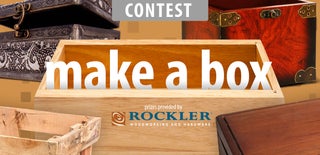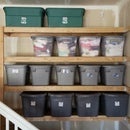Introduction: Coffee Table to Hope Chest
This is a simple weekend project for anyone looking to add a little space in their home.
Hopefully this instructable will be inspiring and informative to any weekend worrier who's eager for the next fix! I try to be less "wordy" and, for the most part, allow the pictures speak for themselves.
Time to complete:
4 hours plus paint drying
Supplies needed:
Coffee table
Paint & Supplies
Plywood
Wood Molding
Hinges
Wood Glue
Tools Needed:
Miter Saw
Table Saw
Router
Brad Nailer
Pliars
Rotary Tool
Hammer
Chisel
Total Costs:
$100
Step 1: Tear Down
Simply remove all the screws and take apart the whole table.
Keep track of everything by keeping them in a container.
My table had lots of staples in it so be sure to remove anything that might poke out and cut you.
Step 2: Groove the Legs
I wanted the plywood to insert into a groove in the side of each leg. Unfortunately, their size and shape was very irregular. Each side tapered down making it hard to align things properly. Ultimately, I set up a rig with my table saw and clamped the legs down using a wedge and wood clamps. By marking each end of the legs I was able to stay within the desired limits on each end.
Step 3: Cut Off the Top
Before making any cuts I numbered each side to keep track of the pieces.
Step 4: Square Up the Cuts
The ends of the cuts need to be squared up with a chisel. The bigger one can be used to mark a line but if you're not careful you can crack the wood, like I did. Use the smaller one to make incremental cuts.
I then used a rotary tool to clean up the groove and open it up a bit. Having a little wiggle room for inserting the plywood is a nice thing in case they don't line up just right.
Step 5: Soft Edge
Adding a soft edge to any corners will always give a nice touch to any project. It also helps hide any imperfections when aligning the pieces later on.
Step 6: Measuring for the Cut
I replaced the top of the legs on the frame and positioned their respective legs back into position. Doing this allowed me to mark and measure the length needed for the plywood sides.
Step 7: Cut and Reset
After cutting I put it all back together again to see how well they fit. This turned out to be a very easy and accurate way to get the right length.
Step 8: Sanding
Take the time to sand all your parts. If they are already painted you'll need to do this in order to get a good surface to bond with the new paint. Softening out the edges is always nice too.
Step 9: Nailed It!
I positioned the plywood and secured everything in place with pipe clamps. Placing the the top frame on and making minor adjustments, I nailed everything together. A brad nailer with 1 inch, 18 ga nails did the job.
Note: You might notice some of the wood is painted already. Don't do do that. It's easier to save it all for last.
Step 10: Putting on the Bottom
Because the angle cut of the legs I needed to insert the bottom in from underneath to avoid extra large cutouts.
Measure and cut out a notch on each corner.
Step 11: Floor Supports
I cut a few strips of wood to support the floorboard.
With a few brad nails and wood glue these hold really well.
Step 12: Filling the Gaps
The floorboard wasn't large enough to fill the space, leaving gaps around the edges. I cut a couple strips of wood to cover them up and used caulking to fill in other gaps.
FYI, if you want a really nice looking finish paint caulking will make all the difference. You'd be amazed at how well it will hide the imperfections!
Step 13: A Nice Touch
I bought some wood molding to fancy it up a little bit.
Step 14: Softening Corners
The molding didn't match up perfectly with the legs so I used the rotary tool to shave them flush.
Step 15: Paint
Painting should be done last. I initially tried staining before it was put together but i didn't take well. So I ended up doing it all over again at the end of my project. Save yourself the time and paint last.
I added a few felt pads to soften the noise when closing the lid.
Step 16: Making Hinges
I marked the hinges and used the rotary tool to make the cut. I then used the hole from the cut piece to steady my drill as I drilled out 2 additional holes. I then used a grinder to take off any sharp edges.
Also, I used inserts on my vise that hold everything together with rubber pads to prevent scratching.
Step 17: Mounting
After aligning the lid with the bottom I marked for drilling holes. Sometimes it's helpful to use a nail punch tool to prevent the drill from wandering.
Step 18: All Done, Enjoy!!
And there it is! For a little work and a few bucks we have a nice place to keep all our games.
Thanks for reading. I hope you felt inspired by it. Feel free to comment or offer suggestions. I have a few projects on the way so feel free to subscribe to my page.
Please vote for me in the competition, thanks!!

Second Prize in the
Before and After Contest 2016

Participated in the
Living Without Closets Contest

Participated in the
Full Spectrum Laser Contest 2016

Participated in the
Make a Box Contest













